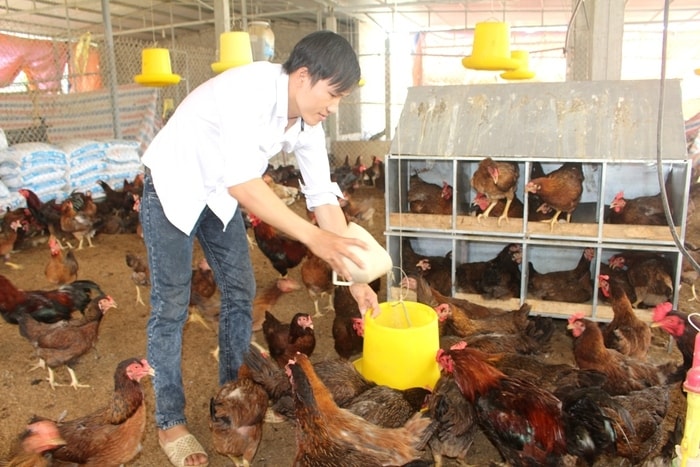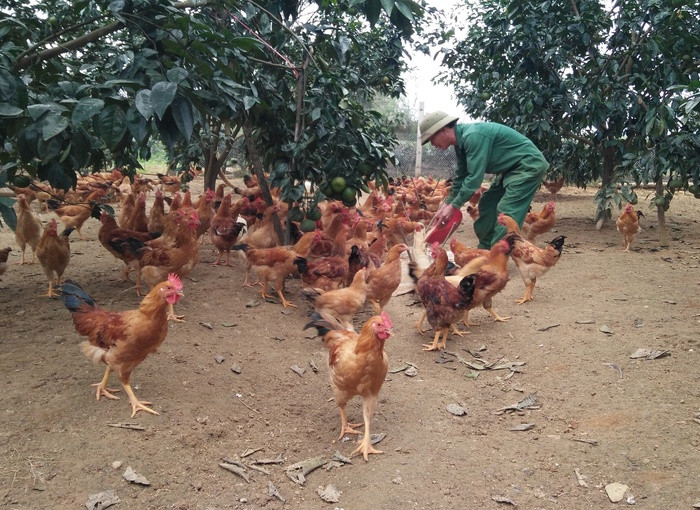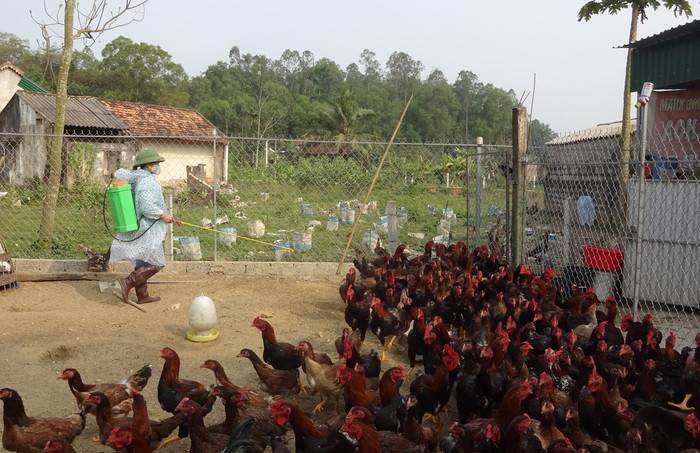How to raise free-range chickens for high economic efficiency
(Baonghean.vn) - Raising free-range chickens is not difficult, but to bring about economic efficiency, farmers must learn and study techniques to apply to household farming.
Treatment of livestock cages
The size of the coop is about 1.5m high, 2.5m long, 2m wide and must have a door for the chickens to go in and out of the rain. The coop floor must be solid and easy to implement disinfection and cleaning measures. The floor should have a slight slope to easily drain water, avoiding wet conditions that cause disease.
The larger the coop area, the better, because open space helps chickens grow quickly; for chicks, the coop density is about 10 - 12 chickens/m2; for broilers, about 5 - 6 chickens/m2.
Chicken coops must have a sewer system to treat waste and wastewater; a sewer line can be dug along the corridor of the coop or an underground system can be built in the coop; the coop must be cleaned, disinfected and sterilized before raising.
 |
Stocking ground
You should choose an open space with hard soil and trees to provide shade for the chickens. Inside, there should be green grass as a natural food source during the raising process. If possible, you should build a temporary shelter to hang additional feeders and waterers for the chickens.
The grazing area must have a large area so that the chickens can search for food and exercise; the minimum area is from 0.5 - 1m2/chicken. If the land is large, the coop should be arranged in the center and 2 grazing areas on both sides for the best results.
The grazing area must be flat, well-drained, free of stagnant water and rubbish; regularly collect fallen feathers from the grazing area.
The surrounding area is fenced with wire mesh or B40 steel mesh, bamboo fence, etc. to ensure safety, to prevent wild animals from entering or stray chickens.
 |
How to choose breeding chickens
To create delicious, quality chicken breeds, the selection of breeds must be very careful; choose chicken breeds with clear origin and reliable address.
Characteristics of standard chicks include straight, steady legs, unbent toes; agile behavior; wide open, alert eyes; eager to run and jump; tail and wings close to the body; large, sturdy beak, not bent, 2 closed beaks; diligent in eating and digging the soil...
 |
How to feed and water chickens
- Stage from 1 - 21 days old:Use 1-21 day old chick feed. Because chicks eat little but often, the feed should be spread thinly and evenly on the tray with a thickness of 1cm; repeat feeding every 3-4 hours. Note that when feeding the next time, you need to remove the remaining food to ensure hygiene for the flock.
During the first 2 weeks, use a 1.5 - 2.0 liter trough; in the following weeks, use a larger trough; the drinking trough must be placed 1 - 3 cm higher than the floor of the cage, placed alternately with the feeding tray, cleaned daily and the water changed 2 - 3 times/day.
- Stage from 21 - 42 days old:Use 21 - 42 day old chicken feed, can mix in rice and green vegetables to increase nutrition for chicken.
During the broiler stage, the feeder must be hung with a rope so that the mouth of the feeder is as high as the chicken's waist. The feeder density is about 30 - 40 chickens/trough; feed the chickens about 3 - 4 times/day.
During this period, drinking troughs should be 4 - 8 liters in capacity, placed 4 - 5 cm higher than the ground; drinking troughs should be placed with 100 pigs per trough; the troughs should be cleaned daily.
- Broiler stage:The amount of food is doubled compared to before, adding protein and many green vegetables for strong bones and heavy weight chickens.
The amount of water in this stage also needs to be increased, always ensure that the drinking trough has enough water; need to monitor the environmental temperature to prevent the chickens from getting too hot, add water so that the chickens do not grow slowly.
 |
Free range chicken care techniques
Free range chickens are easily exposed to external factors, so they easily get sick in bad climate conditions. The best way to get chickens used to the environment is to only let them out for 2 hours/day in the first 5 weeks, then gradually increase to 30 minutes to 1 hour for about 10 days, then they can be released freely.
Always keep an eye on your chickens to monitor their health.
 |
Cleaning chicken coops and equipment
The barn must always be kept clean and hygienic. The surrounding area must be cleared of bushes and the barn must not be wet, moldy or have standing water.
Use disinfectants in the livestock area as directed by your veterinarian.
Periodically turn and add bedding to ensure the necessary thickness and keep the bedding dry and fluffy.
Feeders and drinkers must be cleaned and sanitized daily.
Ngoc Anh
(Synthetic)
| RELATED NEWS |
|---|
